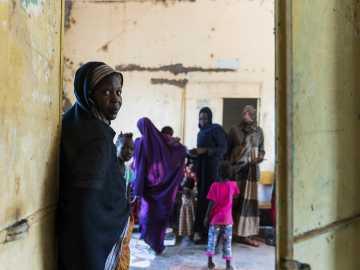
Case Studies
Case Studies
Understanding that the approach presented in the report needs to be tailored to each country, the authors studied the situation of IDPs in protracted situations in five countries: Colombia, DRC, Philippines, Somalia and Ukraine. In each case study attached, the specific causes for protracted displacement are explained. Effective practices in country, as well as concrete recommendations for key stakeholders to tackle protracted internal displacement, are also presented.
Colombia

- Colombia had an estimated 7.1 million IDPs as of the end of 2016.
- The main causes of displacement are armed conflict, violence linked to control over illicit economies, including drug trafficking or illegal mining, and violence associated with land conflicts.
- Most displacement is from rural to urban and peri-urban areas, where most IDPs flee to settle in slums and shanty towns rather than camps.
- Secondary intra- or inter-urban displacement due to threats and violence by criminal elements or people associated with armed groups is common.
- Disasters triggered by natural hazards are another important driver of displacement, with reportedly 3.32 million people displaced between 2008 and 2013.
- New displacement occurs on a regular basis, but most IDPs have lived in protracted displacement for several years or even decades.
 Colombia case study
Colombia case study
Democratic Republic of the Congo
- Internal displacement is an essential feature of the humanitarian crisis in DRC, particularly in the eastern provinces, where the security situation remains volatile.
- About one in 10 people have been internally displaced since 2009.
- Displacement in DRC is heterogeneous in terms of patterns, causes and dynamics.
- Many IDPs are displaced and stay in one place of refuge for the duration of their displacement, as in North Kivu.
- However, IDPs in South Kivu and other areas also commonly use a strategy known as déplacement pendulaire. This means that, security allowing, they return to care for their agricultural land during the day and sleep in the place of displacement.
- Others may be displaced multiple times for relatively short periods, returning to their place of origin when it is deemed safe, only to be displaced again months or years later, further undermining their resilience.
 DRC case study [full study - at a glance]
DRC case study [full study - at a glance]
The Philippines

- Most ongoing internal displacement in the Philippines is located in Mindanao, which comprises several southern islands with ongoing armed conflict, violence and the country’s highest poverty levels.
- Natural hazards, such as typhoons and floods, regularly displace significant numbers of people in other parts of the country, placing the Philippines among the top 10 countries worldwide with the highest number of people displaced by disasters per capita.
- In conflict and disaster contexts, internal displacement in the Philippines is largely characterized as short term, with people being brought to evacuation camps or seeking shelter in neighbouring villages with host families or urban areas.
- However, protracted displacement, as understood in this study, can also take the form of multiple displacements, which is common in the Philippines, particularly in conflict-affected areas of Mindanao.
 Philippines case study
Philippines case study
 Mindanao displacement interactive
Mindanao displacement interactive
Somalia

- With the number of IDPs approaching an estimated 1.5 million people, about 9 per cent of Somalia’s population is internally displaced.
- New displacement takes place every year, but the large majority of Somali IDPs are in protracted displacement.
- These IDPs fled armed conflict, with others displaced after many years of inter-clan violence and armed conflict, and the 2011/12 drought and famine. Others had to move due to forced evictions.
- Most recently, the successive failure of two rainy seasons and the looming fear of famine amid an ongoing background of insecurity and conflict have forced about 400,000 people to move, mostly towards cities and towns, with the number continuing to rise.
- Many IDPs have been displaced several times due to various causes.
 Somalia case study
Somalia case study
Ukraine
- Internal displacement in Ukraine is primarily due to the armed conflict in the country’s eastern Donbass region that started in April/May 2014.
- Presently, more than 1.7 million people are officially registered as IDPs, primarily due to conflict in the east of the country, but also due to the annexation of Crimea by Russia. The number of people displaced inside the non-Government-controlled areas is unknown.
- The majority of IDPs remain close to their original homes.
- The capital, Kiev, hosts more than 100,000 IDPs, with the remaining IDPs living in other locations across the country.
- Many people who are registered as IDPs in the Government-controlled areas of the eastern oblasts move back and forth between the so-called contact line (which separates the parties to the conflict) to access social payments and markets, and to keep family ties.
- Displacement in Ukraine is relatively recent, but there is widespread consensus among national and international actors that in the absence of any progress in the peace process, Ukraine will need to face the challenge of protracted internal displacement.










